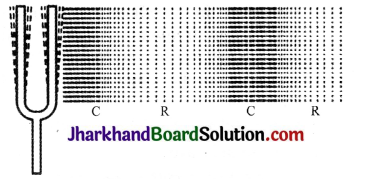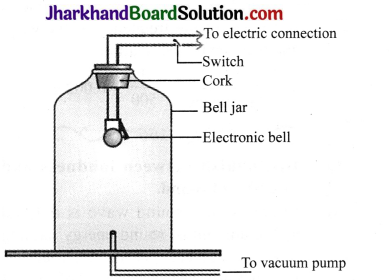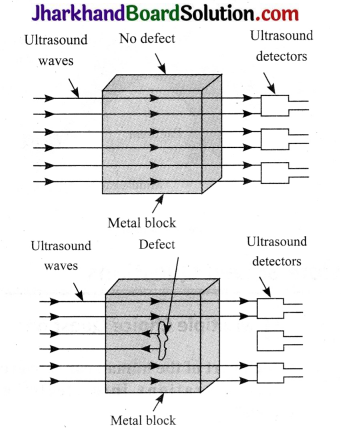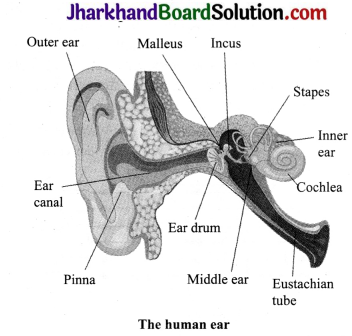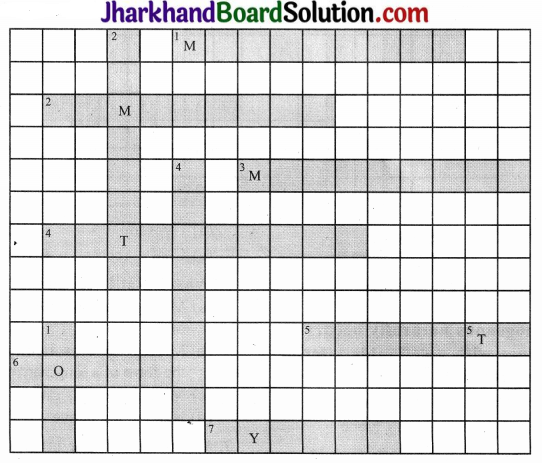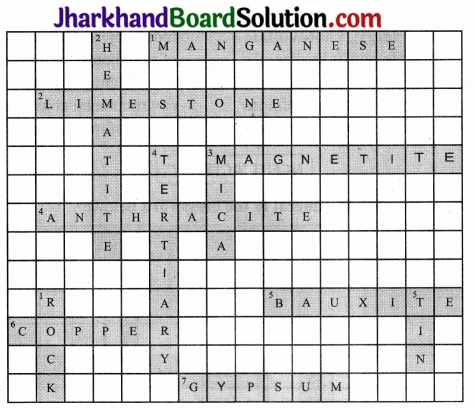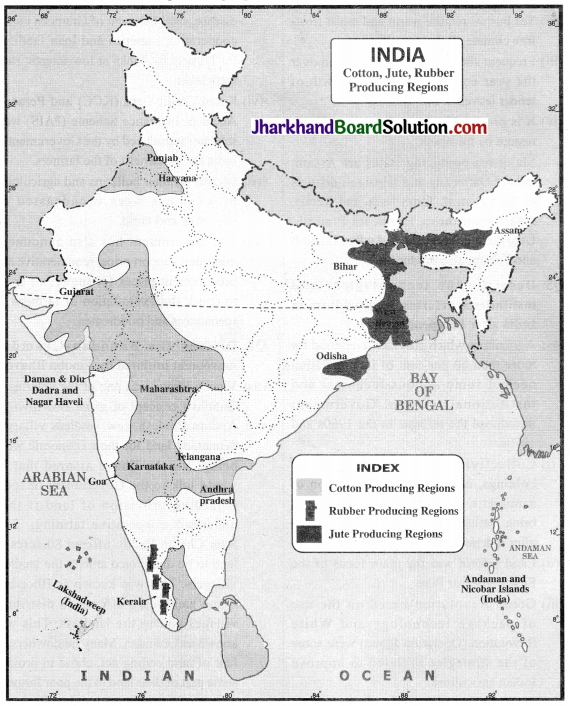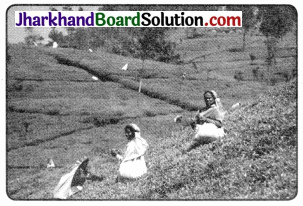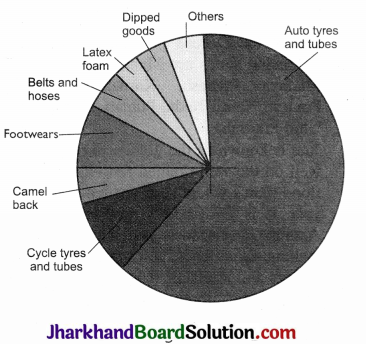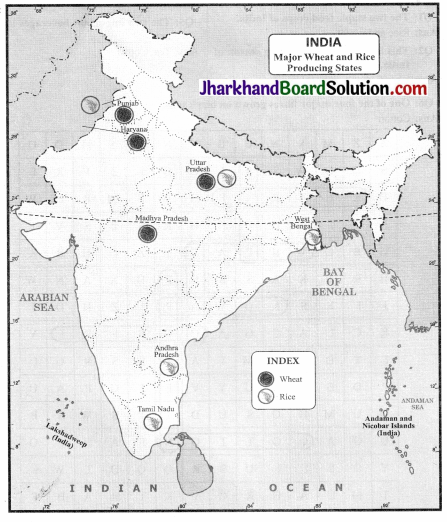Jharkhand Board JAC Class 11 History Solutions Chapter 3 तीन महाद्वीपों में फैला हुआ साम्राज्य Textbook Exercise Questions and Answers.
JAC Board Class 11 History Solutions Chapter 3 तीन महाद्वीपों में फैला हुआ साम्राज्य
Jharkhand Board Class 11 History तीन महाद्वीपों में फैला हुआ साम्राज्य In-text Questions and Answers
पृष्ठ 63
प्रश्न 1.
रोमन साम्राज्य के राजनीतिक इतिहास में कौन तीन मुख्य खिलाड़ी थे? प्रत्येक के बारे में एक-दो पंक्तियाँ लिखिए।
उत्तर:
रोमन साम्राज्य के राजनीतिक इतिहास में तीन मुख्य खिलाड़ी – रोमन साम्राज्य के राजनीतिक इतिहास में निम्नलिखित तीन मुख्य खिलाड़ी थे –
(1) सम्राट्
(2) सैनेट
(3) सेना।
(1) सम्राट्-सम्राट् साम्राज्य का एकछत्र शासक और सत्ता का वास्तविक स्रोत था। वह एक ‘प्रमुख नागरिक’ कहलाता था। ऐसा ‘सैनेट’ को सम्मान प्रदान करने के लिए किया गया था।
(2) सैनेट – सैनेट में धनी परिवारों के एक छोटे से समूह का बोलबाला रहता था, जिन्हें ‘अभिजात’ कहा जाता था। रोम में सैनेट का अस्तित्व कई शताब्दियों तक रहा। इसमें कुलीन एवं अभिजात वर्गों के लोगों का प्रतिनिधित्व था, परन्तु कालान्तर में इतालवी मूल के जमींदारों को भी सम्मिलित कर लिया गया। जब रोम में एक ‘गणतन्त्र’ था, तब सत्ता पर सैनेट का नियन्त्रण था। सम्राटों की परख इस बात से की जाती थी कि वे सैनेट के प्रति किस प्रकार का व्यवहार करते थे।
(3) सेना – रोम की सेना एक व्यावसायिक सेना थी जिसमें प्रत्येक सैनिक को वेतन दिया जाता था। सेना साम्राज्य की सबसे बड़ी एकल संगठित निकाय थी और उसके पास सम्राटों का भाग्य निर्धारित करने की शक्ति थी।

प्रश्न 2.
रोमन सम्राट् अपने इतने बड़े साम्राज्य पर शासन कैसे कर लेता था ? इसके लिए किसका सहयोग महत्त्वपूर्ण था ?
उत्तर:
सम्पूर्ण रोमन साम्राज्य में दूर-दूर तक अनेक नगर स्थापित किये गए थे जिनके माध्यम से समस्त साम्राज्य पर नियन्त्रण रखा जाता था। भूमध्य सागर के तटों पर स्थापित बड़े शहरी केन्द्र जैसे कार्थेज, सिकन्दरिया तथा एंटिऑक आदि साम्राज्यिक प्रणाली के मूल आधार थे। इन्हीं शहरों के माध्यम से रोमन सरकार प्रान्तीय ग्रामीण क्षेत्रों पर कर लगाने में सफल हो पाती थी, जिनसे साम्राज्य को अधिकांश धन-सम्पत्ति प्राप्त होती थी।
इस प्रकार स्थानीय उच्च वर्ग रोमन साम्राज्य को कर वसूली तथा अपने क्षेत्रों के प्रशासन के कार्य में महत्त्वपूर्ण सहयोग देते थे। दूसरी और तीसरी शताब्दियों में अधिकतर प्रशासक तथा सैनिक अधिकारी इन्हीं उच्च प्रान्तीय वर्गों में से होते थे। इस प्रकार उनका एक नया संभ्रांत वर्ग बन गया जो सैनेट के सदस्यों की तुलना में कहीं अधिक शक्तिशाली था, क्योंकि उसे सम्राटों का समर्थन प्राप्त था।
पृष्ठ 66
क्रियाकलाप 2 : रोमन साम्राज्य में ‘स्त्रियाँ’ कहाँ तक आत्मनिर्भर थीं? रोमन परिवार की स्थिति की तुलना आज के भारतीय परिवार की स्थिति से करो।
उत्तर:
रोमन साम्राज्य में स्त्रियाँ काफी आत्मनिर्भर थीं। स्त्री अपने पति को अपनी सम्पत्ति हस्तान्तरित नहीं करती थी। वह अपने पैतृक परिवार में अपने पूरे अधिकार बनाए रखती थी। यद्यपि महिला का दहेज वैवाहिक अवधि के दौरान उसके पति के पास चला जाता था, किन्तु महिला अपने पिता की मुख्य उत्तराधिकारी बनी रहती थी और अपने पिता की मृत्यु के उपरान्त उसकी सम्पत्ति की स्वतन्त्र मालिक बन जाती थी। इस प्रकार रोम की स्त्रियों को सम्पत्ति के स्वामित्व तथा संचालन में अनेक कानूनी अधिकार प्राप्त थे। कानून के अनुसार पति-पत्नी को संयुक्त रूप से एक वित्तीय हस्ती नहीं, बल्कि अलग-अलग दो वित्तीय हस्तियाँ माना जाता था तथा पत्नी को पूर्ण कानूनी स्वतन्त्रता प्राप्त थी। रोम में तलाक देना अपेक्षाकृत सरल था।
रोमन परिवार की स्थिति की वर्तमान भारतीय परिवार की स्थिति से तुलना –
(i) एकल परिवार के स्वरूप में अन्तर – रोमन समाज में एकल परिवार का व्यापक रूप से चलन था। वयस्क पुत्र अपने पिता के परिवार के साथ नहीं रहते थे। वयस्क भाई भी बहुत कम साझे परिवार में रहते थे। दूसरी ओर, दासों को परिवार में सम्मिलित किया जाता था क्योंकि रोमवासियों के लिए परिवार की यही अवधारणा थी। वर्तमान भारत में भी एकल परिवार का व्यापक चलन है अधिकांश वयस्क पुरुष एकल परिवार में रहना पसन्द करते हैं। परन्तु वे अपने परिवारों में दासों को सम्मिलित नहीं करते।
(ii) स्त्रियों की आत्मनिर्भरता सम्बन्धी अन्तर – रोमन साम्राज्य में स्त्रियाँ काफी आत्मनिर्भर थीं। यद्यपि शहरों में रहने वाली भारतीय महिलाएँ कुछ सीमा तक आत्मनिर्भर हैं, परन्तु उनकी संख्या काफी सीमित है। ग्रामीण स्त्रियाँ पूरी तरह से पुरुषों पर निर्भर रहती हैं।

(iii) विवाह सम्बन्धी अन्तर – रोम में पुरुष 28-29, 30-32 की आयु में विवाह करते थे तथा लड़कियाँ 16-18 तथा 22-23 की आयु में विवाह करती थीं। परन्तु भारत में 18 वर्ष के लड़के तथा लड़की को वयस्क माना जाता है। 18 वर्ष से कम आयु की लड़की को विवाह करने का वैधानिक अधिकार प्राप्त नहीं है। भारत में शहरों में रहने वाले पुरुष प्रायः 25-26 वर्ष की आयु में तथा लड़कियाँ प्राय: 22-23 वर्ष की आयु में विवाह करना पसन्द करते हैं। फिर भी स्त्रियों को अनेक सामाजिक और आर्थिक विषमताओं का सामना करना पड़ता है1
(iv) तलाक सम्बन्धी अन्तर – रोम में तलाक देना अपेक्षाकृत सरल था, परन्तु भारतीय महिलाओं के लिए तलाक देने की प्रक्रिया काफी जटिल है।
(v) पति – पत्नी सम्बन्ध सम्बन्धी तुलना-रोम में महिलाओं पर उनके पतियों का प्रभुत्व रहता था और वे प्रायः अपनी पत्नियों की पिटाई करते थे। पिताओं का अपने बच्चों पर अत्यधिक कानूनी नियन्त्रण होता था। अवांछित बच्चों के मामले में उन्हें जीवित रखने या मार डालने का कानूनी अधिकार प्राप्त था। यद्यपि वर्तमान भारतीय परिवारों में भी पुरुषों. की प्रधानता स्थापित है, परन्तु प्रायः पुरुष अपनी पत्नियों की पिटाई करना पसन्द नहीं करते। उनका अपने बच्चों पर कानूनी नियन्त्रण भी नहीं होता है अर्थात् अवांछित बच्चों के मामले में उन्हें अपने बच्चों को मार डालने का कानूनी अधिकार प्राप्त नहीं है।
पृष्ठ 67
क्रियाकलाप 3 : मिट्टी के बर्तनों के अवशेषों पर काम करने वाले पुरातत्त्वविद् बहुत कुछ जासूसों की तरह होते हैं। क्यों? स्पष्ट करो। ‘एम्फोरा’ हमें रोमन काल के भूमध्यसागरीय क्षेत्र के आर्थिक जन-जीवन के बारे में क्या बताते हैं?
उत्तर:
मिट्टी के बर्तनों के अवशेषों पर काम करने वाले पुरातत्त्वविद् बहुत कुछ जासूसों की तरह होते हैं। शराब, जैतून का तेल तथा अन्य तरल पदार्थों की ढुलाई ऐसे मटकों या कंटेनरों में होती थी जिन्हें ‘एम्फोरा’ कहते थे। इन मटकों के टूटे हुए टुकड़े बहुत बड़ी संख्या में अभी भी विद्यमान हैं।
पुरातत्त्वविद् इन टुकड़ों को ठीक से जोड़कर इन कंटेनरों को फिर से सही रूप देने और यह पता लगाने में सफल हुए हैं कि उनमें क्या-क्या ले जाया जाता था। इसके अतिरिक्त, प्राप्त वस्तुओं की मिट्टी का भूमध्यसागरीय क्षेत्रों में उपलब्ध चिकनी मिट्टी के नमूनों के साथ मिलाने करके पुरातत्त्वविद् हमें उनके निर्माण-स्थल के बारे में जानकारी देने में सफल हुए हैं। इसी प्रकार जासूस विभिन्न साक्ष्यों को इकट्ठा कर, उनका विश्लेषण कर अज्ञात एवं रहस्यात्मक तथ्यों का पता लगा लेते हैं।

भूमध्यसागरीय क्षेत्र में अनेक खुदाई के स्थलों पर पाए गए भिन्न-भिन्न प्रकार के एम्फोरा पात्रों के अवशेषों और उनके मिलने के स्थानों के आधार पर पुरातत्त्वविद् यह बताने में सफल हुए हैं कि स्पेन के जैतून के तेल के उत्पाद अपने इतालवी प्रतिद्वन्द्वियों से तेल का बाजार छीनने में सफल हुए।
बाद में उत्तरी अफ्रीका के उत्पादकों ने स्पेन के जैतून के तेल के उत्पादकों जैसा स्थान प्राप्त कर लिया और तीसरी तथा चौथी शताब्दियों के अधिकांश भाग में इनका उस क्षेत्र में वर्चस्व रहा। दूसरे शब्दों में, भिन्न-भिन्न प्रदेशों के जमींदार एवं उत्पादक अलग-अलग वस्तुओं का बाजार हथियाने क लिए आपस में प्रतिस्पर्द्धा करते थे। पुरातत्त्वविदों की भाँति जासूस भी विभिन्न घटनाओं के साक्ष्यों को इकट्ठा कर, उनका विश्लेषण कर निष्कर्ष निकाल लेते हैं।
पृष्ठ 70
क्रियाकलाप 4: इस अध्याय में तीन ऐसे लेखकों का उल्लेख किया गया है जिनकी रचनाओं का प्रयोग यह बताने के लिए किया गया है कि रोम के लोग अपने कामगारों के साथ कैसा बर्ताव करते थे? क्या आप उनके नाम बता सकते हैं? उस अनुभाग को स्वयं फिर से पढ़िए और उन दो तरीकों का वर्णन कीजिए जिनकी सहायता से रोम के लोग अपने श्रमिकों पर नियन्त्रण रखते थे।
उत्तर:
रोमन लोगों का अपने कामगारों के साथ बर्ताव – निम्नलिखित तीन लेखकों कोलूमेल्ला, वरिष्ठ प्लिनी तथा आगस्टीन ने अपनी रचनाओं में यह बताया है कि रोम के लोग अपने कामगारों के साथ कैसा बर्ताव करते थे।
(1) कोलूमेल्ला (निरीक्षण द्वारा श्रमिकों पर नियन्त्रण) – दक्षिणी स्पेन से आए पहली शताब्दी के लेखक कोलूमेल्ला ने सिफारिश की थी कि जमींदारों को अपनी आवश्यकता से दुगुनी संख्या में उपकरणों तथा औजारों का सुरक्षित भण्डार रखना चाहिए जिससे उत्पादन निरन्तर होता रहे क्योंकि दास सम्बन्धी श्रम- समय की हानि ऐसी मदों की लागत से अधिक बैठती है।
मालिकों की यह आम धारणा थी कि निरीक्षण बिना कभी भी कोई काम ठीक से नहीं करवाया जा सकता। इसलिए मुक्त तथा दास दोनों प्रकार के श्रमिकों के लिए निरीक्षण सर्वाधिक महत्त्वपूर्ण पक्ष था। निरीक्षण को सरल बनाने के लिए कामगारों को कभी-कभी छोटे दलों में बाँट दिया जाता था। कोलूमेल्ला ने दस-दस श्रमिकों के समूह बनाने का सुझाव दिया था और उसने यह दावा किया कि इन छोटे समूहों में यह बताना अपेक्षाकृत सरल होता है कि उनमें से कौन काम कर रहा है और कौन काम नहीं कर रहा है।
(2) वरिष्ठ प्लिनी (श्रमिकों को दागना) – प्रकृति विज्ञान के प्रसिद्ध लेखक वरिष्ठ प्लिनी ने दास – समूहों के प्रयोग की यह कहकर निन्दा की कि यह उत्पादन आयोजित करने का सबसे खराब तरीका है क्योंकि इस प्रकार पृथक् – पृथक् समूह में काम करने वाले दासों को प्राय: पैरों में जंजीर डालकर एक-साथ रखा जाता था। ऐसे तरीके कठोर और क्रूर मालूम होते हैं, परन्तु हमें यह नहीं भूलना चाहिए कि आज विश्व में ज्यादातर कारखाने श्रम नियन्त्रण के कुछ इसी प्रकार के सिद्धान्त लागू करते हैं। वास्तव में रोमन साम्राज्य में कुछ औद्योगिक प्रतिष्ठानों ने तो इससे भी अधिक कठोर नियन्त्रण लागू कर रखे थे।

वरिष्ठ प्लिनी ने सिकन्दरिया की फ्रैंकिन्सेंस अर्थात् सुगन्धित राल के कारखानों की स्थिति का वर्णन किया है। “कामगारों के एप्रेनों पर एक सील लगा दी जाती है, उन्हें अपने सिर पर एक गहरी जाली वाला मास्क या नेट पहनना पड़ता है और उन्हें कारखाने से बाहर जाने के लिए अपने सभी कपड़े उतारने पड़ते हैं। ” तीसरी शताब्दी के राज्यादेश में मिस्र के किसानों द्वारा अपने गाँव छोड़ कर जाने का उल्लेख है जिसमें यह कहा गया है कि वे इसलिए गाँव छोड़कर जा रहे थे ताकि उन्हें खेती के काम में न लगना पड़े।
शायद यही बात ज्यादातर फैक्ट्रियों और कारखानों पर लागू होती थी। 398 ई. के एक कानून में यह कहा गया है कि कामगारों को दागा जाता था ताकि यदि वे भागने और छिपने का प्रयत्न करें तो उन्हें पहचाना जा सके। कई निजी स्वामी कामगारों के साथ ऋण- संविदा के रूप में करार ले लेते थे ताकि वे यह दावा कर सकें कि उनके कर्मचारी उनके कर्जदार हैं और इस प्रकार वे अपने कामगारों पर कड़ा नियन्त्रण रखते थे। बहुत से निर्धन परिवारों ने तो जीवित रहने के लिए ही कर्जदारी स्वीकार कर ली थी।
(3) आगस्टीन – अभी हाल ही में खोजे गए आगस्टीन के पत्रों में से एक पत्र से हमें ज्ञात होता है कि कभी-कभी माता-पिता अपने बच्चों को 25 वर्ष के लिए बेचकर बन्धुआ मजदूर बना देते थे। आगस्टीन ने एक बार अपने एक वकील मित्र से पूछा कि पिता की मृत्यु हो जाने पर क्या इन बच्चों को स्वतन्त्र किया जा सकता था। ग्रामीण ऋणग्रस्तता और भी अधिक व्यापक थी। इस ऋणग्रस्तता का एक उदाहरण इस घटना से मिलता है कि 66 ईस्वी के प्रबल यहूदी विद्रोह में क्रान्तिकारियों ने जनता का समर्थन प्राप्त करने के लिए साहूकारों के ऋण-पत्र (बॉण्ड) नष्ट कर दिये थे।
रोमन लोगों द्वारा अपने श्रमिकों पर नियन्त्रण के दो तरीके –
(1) निरीक्षण द्वारा – रोमन मालिकों की यह मान्यता थी कि निरीक्षण या देखभाल के बिना कोई भी कार्य ठीक ढंग से नहीं करवाया जा सकता। इसलिए मुक्त तथा दास, दोनों प्रकार के श्रमिकों के लिए निरीक्षण एक महत्त्वपूर्ण कार्य था। निरीक्षण को सरल बनाने हेतु कामगारों को कभी-कभी छोटे दलों में बाँट दिया जाता था।
(2) श्रमिकों को दागना – रोमन साम्राज्य में कामगारों को दागने की प्रथा प्रचलित थी, रोम में 398 के एक कानून में यह कहा गया है कि कामगारों को दागा जाता था, जिससे यदि वे भागने और छिपने का प्रयत्न करें, तो उन्हें पहचाना जा सके। कई निजी मालिक कामगारों के साथ ऋण संविदा के रूप में एक समझौता कर लेते थे ताकि वे यह दावा कर सकें कि उनके कर्मचारी उनके कर्जदार हैं और इस प्रकार वे अपने कामगारों पर कड़ा नियन्त्रण रखते थे। आगस्टीन के एक पत्र से ज्ञात होता है कि कभी-कभी माता-पिता अपने बच्चों को 25 वर्ष के लिए बेच कर बन्धुआ मजदूर बना देते थे। मालिक इन बच्चों को दाग देते थे ताकि निश्चित अवधि तक वे उनके बन्धुआ मजदूर ही रहे।
Jharkhand Board Class 11 History तीन महाद्वीपों में फैला हुआ साम्राज्य Text Book Questions and Answers
लघूत्तरात्मक प्रश्न –
प्रश्न 1.
यदि आप रोम साम्राज्य में रहे होते, तो कहाँ रहना पसन्द करते- नगरों में या ग्रामीण क्षेत्र में ? कारण बताइए थी।
उत्तर- यदि मैं रोम साम्राज्य में रहा होता, तो नगरों में रहना पसन्द करता। इसके निम्नलिखित कारण थे –
(1) शहरों में खाने-पीने की कोई कमी नहीं थी।
(2) अकाल के दिनों में भी शहरों में ग्रामीण क्षेत्रों की तुलना में अच्छी सुविधाएँ प्राप्त होने की सम्भावना रहती
(3) सार्वजनिक स्नान – गृह रोम के शहरी जीवन की एक प्रमुख विशेषता थी।
(4) शहरी लोगों को उच्चस्तर के मनोरंजन उपलब्ध थे।

(5) शहर उद्योग-धन्धों एवं व्यापार के भी प्रमुख केन्द्र होते थे। नगरों में अनेक खानें, खदानें, ईंट-भट्टे, जैतून के तेल की फैक्टरियाँ आदि उपलब्ध थीं जिससे वहाँ का आर्थिक आधारभूत ढाँचा सुदृढ़ था। यहाँ आजीविका कमाने की कोई समस्या नहीं थी। लोगों का जीवन स्तर उन्नत था। उनका जीवन सुख-सुविधाओं से परिपूर्ण था। शहर आर्थिक सम्पन्नता के केन्द्र बने हुए थे।
(6) नगरों में साक्षरता की दर भी अधिक थी। नगरों में अनेक विद्यालय स्थापित थे, जहाँ विद्यार्थी शिक्षा प्राप्त करते थे।
(7) नगरों में लोगों का जीवन ग्रामीण लोगों के जीवन की अपेक्षा सुरक्षित था। नगर प्रशासनिक इकाइयों के रूप में क्रियाशील थे। इसलिए वहाँ पर लोगों की सुख-सुविधाओं पर ज्यादा ध्यान दिया जाता था।
प्रश्न 2.
इस अध्याय में उल्लिखित कुछ छोटे शहरों, बड़े नगरों, समुद्रों और प्रान्तों की सूची बनाइये और उन्हें नक्शे पर खोजने की कोशिश कीजिये। क्या आप अपने द्वारा बनाई गई सूची में संकलित किन्हीं तीन विषयों के बारे में कुछ कह सकते हैं?
उत्तर:
(1) छोटे शहरों की सूची – इटली में कैम्पेनिया, सिसली, पोम्पेई, मिस्र में फैय्यूम, गैलिली, बाइजैकियम ( ट्यूनीशिया), दक्षिणी गाल, बेटिका, हिसपेनिया, नुमीडिया। आदि।
(2) बड़े शहरों की सूची – कार्थेज, एंटिओक, कुंस्तुन्तुनिया, सिकन्दरिया, रोम, बगदाद, दमिश्क, मक्का, मदीना
(3) समुद्रों की सूची – अटलांटिक महासागर, लाल सागर, काला सागर, कैस्पियन सागर, एड्रियाटिक सागर, आयोनियन सागर, एजियन सागर, टिरेनियन सागर, भूमध्यसागर।
(4) प्रान्तों की सूची – गाल (आधुनिक फ्रांस), हिसपेनिया, बेटिका, ब्रिटेन, मारिटामिया ( मोरक्को), ट्यूनीशिया, मिस्र; मकदूनिया, कैम्पेनिया।
तीन विषयों का वर्णन –
(1) नगर – रोमन साम्राज्यं के नगर उद्योग, व्यापार, शिक्षा, साहित्य, कला, ज्ञान-विज्ञान आदि के प्रमुख केन्द्र थे। यहाँ के निवासियों को अनेक सुविधाएँ प्राप्त थीं तथा उनका जीवन स्तर उन्नत था।
(2) समुद्र – रोमन साम्राज्य के प्रमुख नगर समुद्रों के किनारों पर स्थित थे। इन मुहानों पर बड़े बन्दरगाह और पत्तन बनाए गए थे। इनके माध्यम से अनेक देशों के साथ व्यापार किया जाता था। रोमन साम्राज्य का व्यापार बहुत उन्नत था।

(3) प्रान्त – इंटली के सिवाय, रोमन साम्राज्य के सभी क्षेत्र प्रान्तों में बँटे हुए थे और उनसे कर वसूला जाता था। सम्पूर्ण साम्राज्य में दूर-दूर तक अनेक नगर स्थापित किए गए थे जिनके माध्यम से समस्त साम्राज्य पर नियन्त्रण रखा जाता था। इन्हीं शहरों के माध्यम से सरकार प्रान्तीय ग्रामीण क्षेत्रों पर कर लगाती थी। दूसरी और तीसरी शताब्दियों के दौरान अधिकतर प्रशासक तथा सैनिक अधिकारी उच्च प्रान्तीय वर्गों में से होते थे।
प्रश्न 3.
कल्पना कीजिए कि आप रोम की एक गृहिणी हैं जो घर की जरूरत की वस्तुओं की खरीददारी की सूची बना रही हैं। अपनी सूची में आप कौनसी वस्तुएँ शामिल करेंगी?
उत्तर:
यदि मैं रोम की एक गृहिणी होती, तो मैं घर की जरूरत की वस्तुओं की खरीददारी की सूची में निम्नलिखित वस्तुएँ शामिल करती-गेहूँ, जौ, मक्का, चावल, बाजरा, दालें, सब्जियाँ, फल, दूध, मक्खन, अण्डे, मांस, जैतून का तेल, मसाले, लकड़ी, कोयला, विभिन्न प्रकार के बर्तन, बच्चों, पुरुषों तथा परिवार के अन्य सदस्यों के लिए वस्त्र, बच्चों के लिए खिलौने, खेल-सामग्री तथा अन्य आवश्यक वस्तुएँ, फर्नीचर जैसे कुर्सी, मेज, पलंग, आभूषण, सौन्दर्य प्रसाधन, दवाइयाँ आदि।
प्रश्न 4.
आपको क्या लगता है कि रोमन सरकार ने चाँदी में मुद्रा को ढालना क्यों बन्द किया होगा और वह सिक्कों के उत्पादन के लिए कौनसी धातु का उपयोग करने लगे?
उत्तर:
परवर्ती रोमन साम्राज्य में प्रथम तीन शताब्दियों से प्रचलित चाँदी – आधारित मौद्रिक प्रणाली समाप्त कर दी गई। इसका कारण यह था कि स्पेन की खानों से चाँदी मिलना बन्द हो गया था और रोमन सरकार के पास चाँदी की मुद्रा के प्रचलन के लिए ‘पर्याप्त चाँदी नहीं रह गई थी । इसलिए रोमन सरकार ने चाँदी की मुद्रा को ढालना बन्द कर दिया। दूसरी ओर रोमन साम्राज्य में सोना प्रचुर मात्रा में उपलब्ध था । अतः रोमन सम्राट कान्स्टैन्टाइन ने सोने पर आधारित नई मौद्रिक – प्रणाली स्थापित की। उसने सालिडास नामक सोने का सिक्का चलाया जो शुद्ध रूप में 45 ग्राम सोने का बना था। यह सिक्का रोमन साम्राज्य स्थापित होने के बाद भी चलता रहा।

निबन्धात्मक प्रश्न
प्रश्न 5.
अगर सम्राट त्राजान भारत पर विजय प्राप्त करने में वास्तव में सफल रहे होते और रोमवासियों का इस देश पर अनेक सदियों तक कब्जा रहा होता, तो क्या आप सोचते हैं कि भारत वर्तमान समय के देश से किस प्रकार भिन्न होता?
उत्तर:
रोमन लोगों के अधीन रहने पर भारत का वर्तमान समय के देश से भिन्न होना यदि सम्राट त्राजान भारत पर विजय प्राप्त करने में वास्तव में सफल रहे होते और रोमवासियों का इस देश पर अनेक सदियों तक कब्जा रहा होता, तो भारत वर्तमान समय के देश से काफी भिन्न होता।
(1) प्रशासन – भारतीय प्रशासन परं रोमन प्रशासन का प्रभाव पड़ता। भारत में लोकतन्त्र के स्थान पर राजतन्त्र होता। रोमन साम्राज्य की भाँति भारतीय प्रशासन में सम्राट, सैनेट (अभिजात वर्ग) तथा सेना का प्रमुख स्थान होता। भारत के प्रशासनिक ढाँचे में उन्नति हुई होती।
(2) शहरों का महत्त्व – रोमन साम्राज्य में शहर साम्राज्यिक प्रणाली के मूल आधार थे। इन्हीं शहरों के माध्यम से सरकार प्रान्तीय ग्रामीण क्षेत्रों पर कर लगाने में सफल हो पाती थी। रोम के सन्दर्भ में नगर एक ऐसा शहरी केन्द्र था, जिसके अपने दण्डनायक, नगर परिषद् और अपना एक सुनिश्चित राज्य – क्षेत्र था जिसमें अनेक ग्राम शामिल थे। भारत में भी शहरों के राजनीतिक, आर्थिक, सामाजिक महत्त्व में वृद्धि होती। सार्वजनिक स्नान-गृह रोम के शहरी जीवन की एक प्रमुख विशेषता थी। शहरी लोगों को उच्च स्तर के मनोरंजन उपलब्ध थे। भारत के शहरी जीवन पर भी इसका प्रभाव पड़ता।
(3) स्त्रियों की स्थिति – रोम की महिलाओं को सम्पत्ति के स्वामित्व व संचालन में व्यापक कानूनी अधिकार प्राप्त थे तलाक देना अपेक्षाकृत सरल था और इसके लिए पति अथवा पत्नी द्वारा केवल विवाह – भंग करने के निश्चय की सूचना देना ही पर्याप्त था। इस प्रकार भारत में तलाक देना और सरल हो जाता। रोम में बाल विवाह का प्रचलन नहीं था। अतः भारत में भी बाल-विवाह का प्रचलन नहीं होता।

(4) परिवार – रोम में एकल परिवार का व्यापक रूप से प्रचलन था । अतः भारत में संयुक्त परिवार प्रथा की बजाय एकल परिवार का ही प्रचलन होता। रोम में परिवार में पिता का अपने बच्चों पर अत्यधिक कानूनी नियन्त्रण होता था। भारतीय परिवारों पर भी इसका प्रभाव पड़ता।
(5) आर्थिक क्षेत्र में उन्नति – रोमन साम्राज्य का आर्थिक आधारभूत ढाँचा काफी सुदृढ़ था। रोमन साम्राज्य में व्यापार की अत्यधिक उन्नति हुई थी। वहाँ के अनेक क्षेत्र अत्यधिक उपजाऊ थे। वहाँ उत्पादकता का स्तर बहुत ऊँचा था। वहाँ चाँदी के सिक्कों के स्थान पर सोने के सिक्कों का प्रचलन था। अतः भारत भी आर्थिक क्षेत्र में अत्यन्त समृद्ध होता तथा यहाँ भी सोने के सिक्के प्रचलन में होते। भारत के यूरोपीय देशों के साथ घनिष्ठ सम्बन्ध स्थापित होते।
(6) दास प्रथा – रोम में दास प्रथा का प्रचलन था। दासों के साथ क्रूरतापूर्ण व्यवहार किया जाता था। भारत में भी दास प्रथा का प्रचलन होता।
(7) ईसाई धर्म का प्रचार – रोमन साम्राज्य में ईसाई धर्म का व्यापक प्रचार था। रोमन सम्राट कान्स्टैन्टाइन ने ईसाई धर्म को राजधर्म घोषित कर दिया था। इसका भारत पर भी प्रभाव पड़ता और सम्भवतः ईसाई धर्म को राजधर्म बना दिया जाता।
(8) भारतीय संस्कृति पर प्रभाव – रोमन साम्राज्य का भारतीय संस्कृति पर प्रभाव पड़ने की सम्भावना थी। इससे भारत में पश्चिमीकरण की प्रक्रिया प्रारम्भ हो सकती थी। परिणामस्वरूप रोमन सभ्यता का भारतीय सभ्यता एवं संस्कृति पर प्रभाव पड़ना स्वाभाविक था। इससे भारतीय सभ्यता एवं संस्कृति के आध्यात्मिक तत्त्वों को हानि पहुँच सकती थी तथा भौतिकवाद में वृद्धि हो सकती थी। इसके अतिरिक्त चित्रकला, भवन निर्माण कला, मूर्तिकला पर भी रोमन कला का प्रभाव होता।
प्रश्न 6.
अध्याय को ध्यानपूर्वक पढ़ कर उसमें से रोमन समाज और अर्थव्यवस्था को आपकी दृष्टि में आधुनिक दर्शाने वाले आधारभूत अभिलक्षण चुनिए।
उत्तर:
I. रोमन समाज को आधुनिक दर्शाने वाले आधारभूत अभिलक्षण – रोमन समाज को आधुनिक दर्शाने वाले आधारभूत अभिलक्षण निम्नलिखित हैं –
(1) एकल परिवार – रोमन समाज की अपेक्षाकृत अधिक आधुनिक विशेषताओं में से एक विशेषता यह थी कि उन दिनों एकल परिवार का व्यापक रूप से चलन था। वयस्क पुत्र अपने पिता के परिवारों के साथ नहीं रहते थे तथा वयस्क भाई बहुत कम संयुक्त परिवार में रहते थे।
(2) स्त्रियों की स्थिति – प्रथम शताब्दी ई. पू. तक स्त्रियों को सम्पत्ति सम्बन्धी अनेक अधिकार प्राप्त थे। पत्नी अपने पति को अपनी सम्पत्ति हस्तान्तरित नहीं किया करती थी । परन्तु अपने पैतृक परिवार में वह अपने पूरे अधिकार बनाए रखती थी।
स्त्री का दहेज वैवाहिक अवधि के दौरान उसके पति के पास चला जाता था, परन्तु स्त्री अपने पिता की मुख्य उत्तराधिकारिणी बनी रहती थी और अपने पिता की मृत्यु होने पर उसकी सम्पत्ति की स्वतन्त्र स्वामिनी बन जाती थी। इस प्रकार रोम की स्त्रियों को सम्पत्ति के स्वामित्व व नियन्त्रण में व्यापक कानूनी अधिकार प्राप्त थे। रोम में तलाक देना अपेक्षाकृत सरल था और इसके लिए पति अथवा पत्नी द्वारा केवल विवाह – विच्छेद करने के निश्चय की सूचना देना ही पर्याप्त था।
(3) विवाह – रोमन समाज में वयस्क होने पर ही विवाह किया जाता था। पुरुष 28 – 29, 30-32 की आयु में विवाह करते थे तथा लड़कियाँ 16-18 व 22-23 वर्ष की आयु में विवाह करती थीं।
(4) साक्षस्ता – कामचलाऊ साक्षरता अर्थात् पढ़ने-लिखने की योग्यता की दरें साम्राज्य के विभिन्न भागों में अलग-अलग थीं। एक ओर पोम्पई नगर में काम चलाऊ साक्षरता व्यापक रूप में पाई जाती थी जबकि मिस्र में साक्षरता संजीव पास बुक्स की दर काफी कम थी। यहाँ भी साक्षरता निश्चित रूप से कुछ वर्गों के लोगों जैसे सैनिकों, सैनिक अधिकारियों, सम्पत्ति – प्रबन्धवों आदि में अपेक्षाकृत अधिक व्यापक थी।

(5) सार्वजनिक स्नान गृह – सार्वजनिक स्नान गृह रोम के शहरी जीवन की एक प्रमुख विशेषता थी।
(6) मनोरंजन के साधन – शहरी लोगों को उच्च स्तर के मनोरंजन उपलब्ध थे। उदाहणार्थ, से हमें ज्ञात होता है कि एक वर्ष में कम-से-कम 176 दिन वहाँ कोई-न-कोई मनोरंजक कार्यक्रम या प्रदर्शन अवश्य होता था।
II. रोमन अर्थव्यवस्था को आधुनिक दर्शाने वाले आधारभूत लक्षण –
(1) आर्थिक आधारभूत संरचना का मजबूत होना – रोमन साम्राज्य में बन्दरगाहों, खानों, खदानों, ईंट-भट्टों, जैतून के तेल की फैक्ट्रियों आदि की संख्या काफी अधिक थी जिनसे उसका आर्थिक आधारभूत ढाँचा काफी मजबूत था। गेहूँ, शराब, जैतून का तेल आदि मुख्य व्यापारिक वस्तुएँ थीं। ये वस्तुएँ मुख्यतः स्पेन, गैलिक प्रान्तों, उत्तरी अफ्रीका, मिस्र तथा अपेक्षाकृत कम मात्रा में इटली से आती थीं जहाँ इन फसलों के लिए उपयुक्त स्थितियाँ उपलब्ध थीं।
(2) शराब, जैतून का तेल तथा अन्य तरल पदार्थों की ढुलाई- शराब, जैतून के तेल तथा अन्य तरल पदार्थों की ढुलाई ऐसे मटकों या कन्टेनरों में होती थी जिन्हें ‘एम्फोरा’ कहते थे। स्पेन में जैतून का तेल निकालने का उद्यम 140-160 ई. के वर्ष में अपनी चरम उन्नति पर था । स्पेन में उत्पादित जैतून का तेल मुख्य रूप से ऐसे कन्टेनरों में ले जाया जाता था जिन्हें ‘ड्रेसल – 20’ कहते थे। भिन्न-भिन्न प्रदेशों के जमींदार एवं उत्पादक विभिन्न वस्तुओं के बाजार पर अधिकार करने के लिए आपस में प्रतिस्पर्द्धा करते रहते थे ।
(3) उर्वर प्रदेश – रोमन साम्राज्य के बहुत से प्रदेश अत्यधिक उपजाऊ थे। इन प्रदेशों में इटली में कैम्पैनिया, सिसली, मिस्र में फैय्यूम, गैलिली, बाइजैकियम (ट्यूनीसिया ), दक्षिणी गाल तथा बाएंटिका ( दक्षिणी स्पेन) अपनी असाधारण उर्वरता के लिए प्रसिद्ध थे। स्ट्रैबो तथा प्लिनी जैसे इतिहासकारों के अनुसार ये सभी प्रदेश साम्राज्य के घनी जनसंख्या वाले और सबसे धनी प्रदेशों में से कुछ थे। सबसे बढ़िया किस्म की अंगूरी शराब कैम्पैनिया से आती थी। सिसली और बाइजैकियम रोम को भारी मात्रा में गेहूँ का निर्यात करते थे । गैलिली में गहन खेती की जाती थी। इतिहासकार जोसिफ ने लिखा है कि ” प्रदेशवासियों ने जमीन के एक-एक इंच टुकड़े पर खेती कर रखी है। ”
(4) जल शक्ति का विकास – भूमध्य सागर के आस-पास पानी की शक्ति का भिन्न-भिन्न प्रकार से प्रयोग किया जाता था। इस काल में जल-शक्ति से मिलें चलाने की प्रौद्योगिकी में काफी उन्नति हुई। स्पेन की सोने और चाँदी की खानों में जल – शक्ति से खुदाई की जाती थी और पहली तथा दूसरी शताब्दियों में इन खानों से बड़े पैमाने पर खनिज निकाले जाते थे।
(5) उत्पादकता का स्तर ऊँचा होना- उस समय उत्पादकता का स्तर इतना ऊँचा था कि 19वीं शताब्दी तक अर्थात् लगभग 1700 वर्ष बाद भी ऐसे उत्पादन के स्तर देखने को नहीं मिलते। उस समय सुगठित वाणिज्यिक और बैंकिंग व्यवस्था थी और धन का व्यापक रूप से प्रयोग होता था। रोमन सम्राट कान्स्टैन्टाइन ने ‘सालिडास’ नामक सोने का सिक्का, चलाया, जो रोमन साम्राज्य के समाप्त होने के पश्चात् भी चलता रहा था। परवर्ती काल में साम्राज्य में सोने के सिक्के प्रचलित रहे।

(6) रोमन अभिजात वर्ग के पास अतुल धन-सम्पत्ति का होना – रोमन अभिजात वर्ग के पास अतुल धन- सम्पत्ति थी। बहुत से रोमन परिवारों को अपनी सम्पत्ति से प्रतिवर्ष 4 हजार पौण्ड सोने की आय प्राप्त होती थी, जिसमें अनाज, शराब और अन्य उपज शामिल नहीं थीं। इन उपजों को बेचने पर सोने में प्राप्त आय के एक-तिहाई के बराबर आय हो सकती थी। रोम में ‘द्वितीय श्रेणी के परिवारों की आय 1000 अथवा 1500 पौण्ड सोना थी।
तीन महाद्वीपों में फैला हुआ साम्राज्य JAC Class 11 History Notes
पाठ- सार
1. रोम साम्राज्य- रोम साम्राज्य दूर-दूर तक फैला हुआ था। इसमें आज का अधिकांश यूरोप और उर्वर अर्द्ध- चन्द्राकार क्षेत्र अर्थात् पश्चिमी एशिया तथा उत्तरी अफ्रीका का बहुत बड़ा भाग शामिल था। यह साम्राज्य अनेक स्थानीय संस्कृतियों तथा भाषाओं के वैभव से सम्पन्न था; स्त्रियों की कानूनी स्थिति काफी सुदृढ़ थी। लेकिन अर्थव्यवस्था दास-श्रम के बल पर चलती थी। इस कारण जनता का एक बड़ा भाग स्वतंत्रता से वंचित था। पांचवीं शताब्दी व उसके बाद इसका पश्चिमी साम्राज्य छिन्न-भिन्न हो गया लेकिन पूर्वी भाग अत्यन्त समृद्ध बना रहा।
2. रोमन तथा ईरानी साम्राज्य – ईसा मसीहा के जन्म से लेकर 630 के दशक की अवधि में अधिकांश यूरोप, उत्तरी अफ्रीका और मध्य पूर्व तक के विशाल क्षेत्र में दो सशक्त साम्राज्यों-रोम साम्राज्य और ईरान साम्राज्य-का शासन था तथा ये आपस में संघर्षरत रहे।
3. रोम के इतिहासकारों के पास स्रोत- सामग्री – रोम के इतिहासकारों के पास स्रोत- सामग्री का विशाल भण्डार था। इस स्रोत -सामग्री को तीन वर्गों में बाँटा जा सकता है –
(1) पाठ्य सामग्री
(2) प्रलेख या दस्तावेज
(3) भौतिक अवशेष।
4. रोमन साम्राज्य का आरम्भिक काल – रोमन साम्राज्य को मोटे तौर पर दो चरणों में बाँटा जा सकता है, जिन्हें ‘पूर्ववर्ती चरण’ और ‘परवर्ती चरण’ कहा जा सकता है। रोमन साम्राज्य में प्रशासन के प्रयोजन के लिए लैटिन तथा यूनानी भाषाओं का प्रयोग किया जाता था।
5. पूर्ववर्ती चरण –
(i) गणतन्त्र में वास्तविक सत्ता ‘सैनेट’ नामक निकाय में निहित थी। गणतन्त्र 509 ई. पूर्व से 27 ई. पूर्व तक चला। 27 ई. पूर्व में रोम सम्राट् आगस्टस ने जो राज्य स्थापित किया, उसे ‘प्रिंसिपेट’ कहा जाता था। उसने सैनेट के महत्त्व को बनाए रखा। सैनेट में कुलीन एवं अभिजात वर्गों का प्रतिनिधित्व था। सम्राट और सैनेट के बाद सामाजिक शासन की एक अन्य प्रमुख संस्था सेना थी। यह व्यावसायिक सेना थी। इस प्रकार सम्राट, अभिजात वर्ग तथा सेना साम्राज्य के राजनीतिक इतिहास में तीन मुख्य खिलाड़ी थे। 509 ई. पूर्व से तीसरी शताब्दी के मुख्य भाग तक के काल को पूर्ववर्ती रोमन साम्राज्य कहा जाता है।
(ii) रोमन साम्राज्य का विस्तार – रोमन साम्राज्य के प्रत्यक्ष शासन का काफी विस्तार हुआ। इसके लिए अनेक आश्रित राज्यों को रोम के प्रान्तीय राज्य में सम्मिलित कर लिया गया। दूसरी शताब्दी में रोमन साम्राज्य स्काटलैण्ड से आर्मेनिया की सीमाओं तक और सहारा से फरात तथा कभी-कभी उससे भी आगे तक फैला हुआ था।
(iii) नगरों के माध्यम से साम्राज्य पर नियन्त्रण रखना – सम्पूर्ण साम्राज्य में दूर-दूर तक अनेक नगर स्थापित किये गये थे, जिनके माध्यम से समस्त साम्राज्य पर नियन्त्रण रखा जाता था। इन्हीं नगरों के माध्यम से सरकार प्रान्तीय ग्रामीण क्षेत्रों पर कर लगाने में सफल हो पाती थी।
(iv) सार्वजनिक स्नान गृह – सार्वजनिक स्नानगृह रोम के शहरी जीवन की एक प्रमुख विशेषता थी। शहरी लोगों को उच्च स्तर के मनोरंजन उपलब्ध थे।
(v) तीसरी शताब्दी का संकट – तीसरी शताब्दी में रोम को अनेक संकटों का सामना करना पड़ा। ईरान के शासक शापुर प्रथम ने रोम साम्राज्य की पूर्वी राजधानी एंटिआक पर अधिकार कर लिया। कई जर्मन मूल की जनजातियों ने राइन तथा डेन्यूब नदियों की सीमाओं की ओर बढ़ना शुरू कर दिया और उन प्रान्तों की सीमाओं पर आक्रमण किया।
(vi) लिंग – रोम में एकल परिवार का प्रचलन था। महिलाओं को सम्पत्ति के स्वामित्व तथा संचालन में व्यापक कानूनी अधिकार प्राप्त थे। तलाक देना अपेक्षाकृत आसान था। स्त्रियों पर उनके पतियों का नियन्त्रण रहता था। पिता का अपने बच्चों पर कानूनी नियन्त्रण होता था। कानून के अनुसार पति और पत्नी को अलग-अलग दो वित्तीय हस्तियाँ माना जाता था तथा पत्नी को पूर्ण वैधिक स्वतंत्रता प्राप्त थी।
(vii) साक्षरता- कामचलाऊ साक्षरता की दरें साम्राज्य के विभिन्न भागों में काफी अलग-अलग थीं। पोम्पई नगर में काम-चलाऊ साक्षरता व्यापक रूप में विद्यमान थी।
(viii) संस्कृति – रोमन साम्राज्य में सांस्कृतिक विविधता कई रूपों में दिखाई देती है, जैसे-धार्मिक सम्प्रदायों तथा स्थानीय देवी-देवताओं की भरपूर विविधता, बोलचाल की अनेक भाषाएँ, वेशभूषा की विविध शैलियाँ, अलग-अलग प्रकार के भोजन आदि।
(ix) आर्थिक विस्तार – साम्राज्य में बन्दरगाहों, खदानों, ईंट-भट्टों, जैतून के तेल के कारखानों आदि की संख्या काफी अधिक थी। गेहूँ, अंगूरी शराब तथा जैतून का तेल मुख्य व्यापारिक मदें थीं। इटली में कैम्पेनिया, सिसली, मिस्र में फैय्यूम, गैलिली, बाइजैकियम, दक्षिणी गाल तथा बाएटिका अत्यधिक उपजाऊ क्षेत्र थे।
सिसली तथा बाइजैकियम रोम को भारी मात्रा में गेहूँ का निर्यात करते थे। परन्तु रोम क्षेत्र के अनेक बड़े-बड़े हिस्से बहुत कम उन्नत अवस्था में थे। स्पेन की सोने और चाँदी की खानों में जल – शक्ति से खुदाई की जाती थी और इन खानों से खनिज निकाले जाते थे। उत्पादकता का स्तर ऊँचा था। बैंकिंग व्यवस्था थी।
(x) श्रमिकों पर नियन्त्रण – रोमन साम्राज्य में दासों की बहुत बड़ी संख्या थी। जहाँ उच्च वर्ग के लोग दासों के प्रति प्राय: क्रूरतापूर्ण व्यवहार करते थे, वहीं दूसरी ओर साधारण लोग उनके प्रति कहीं अधिक सहानुभूति रखते थे। जब दासों की आपूर्ति में कमी आने लगी तो दास प्रजनन अथवा वेतनभोगी मजदूरों जैसे विकल्पों का सहारा लिया गया। रोमन साम्राज्य में कुछ औद्योगिक प्रतिष्ठानों ने श्रमिकों से सम्बंन्धित कड़े नियन्त्रण लगा रखे थे। कामगारों को दागा जाता था ताकि यदि वे भागने का प्रयत्न करें तो उन्हें पहचाना जा सके।
(xi) सामाजिक श्रेणियाँ – साम्राज्य में सैनेटर, अश्वारोही वर्ग, जनता का सम्माननीय वर्ग, निम्नतर वर्ग, दास आदि विभिन्न सामाजिक समूह थे। सैनेटर तथा अश्वारोही वर्ग अभिजात वर्ग थे। मध्यम वर्ग में नौकरशाही और सैनिक लोग शामिल थे, परन्तु इसमें समृद्ध सौदागर तथा किसान भी शामिल थे। निम्नतर वर्ग में ग्रामीण श्रमिक शामिल थे।
6. परवर्ती पुराकाल या परवर्ती साम्राज्य – तीसरी शताब्दी के उत्तरार्द्ध से लेकर सातवीं शताब्दी तक के काल में परवर्ती रोमन साम्राज्य के नाम से जाना जाता है। सम्राट डायोक्लीशियन (284-305 ई.) ने सामरिक तथा आर्थिक दृष्टि से महत्त्वहीन क्षेत्रों को छोड़कर साम्राज्य के विस्तार को कम किया। सम्राट कांस्टेन्टाइन ने इनके अतिरिक्त कुछ अन्य परिवर्तन साम्राज्य के अन्तर्गत किए।
यथा –
- सम्राट कान्स्टैन्टाइन ने ‘सालिडस’ नामक एक नया सिक्का चलाया।
- उसने दूसरी राजधानी कुस्तुन्तुनिया का निर्माण किया।
- उसके समय में तेल की मिलों, शीशे के कारखानों आदि की स्थापना हुई। इन सभी के फलस्वरूप शहरी सम्पदा और समृद्धि में अत्यधिक वृद्धि हुई।
- धार्मिक स्थिति – रोमन लोग अनेक देवी-देवताओं की उपासना करते थे। ये लोग जूपिटर, जूनो, मिनर्वा, मार्स आदि अनेक देवताओं की पूजा करते थे। यहूदी धर्म रोम साम्राज्य का एक अन्य बड़ा धर्म था। चौथी या पाँचवीं शताब्दियों में साम्राज्य का ईसाईकरण हुआ।
- रोमन साम्राज्य का पतन – जर्मन मूल के अनेक समूहों ने पश्चिमी साम्राज्य के सभी बड़े प्रान्तों पर अधिकार कर लिया और अपने-अपने राज्य स्थापित कर लिए जिन्हें रोमोत्तर राज्य कहा जा सकता है। सातवीं शताब्दी के प्रारम्भिक दशकों तक आते-आते रोम और ईरान के बीच लड़ाई फिर छिड़ गई। ईरानी शासकों ने मिस्र सहित सभी विशाल पूर्वी प्रान्तों परं आक्रमण कर दिया। 642 तक अरबों ने पूर्वी रोमन और ससानी दोनों राज्यों के बड़े-बड़े भागों पर अधिकार कर लिया।
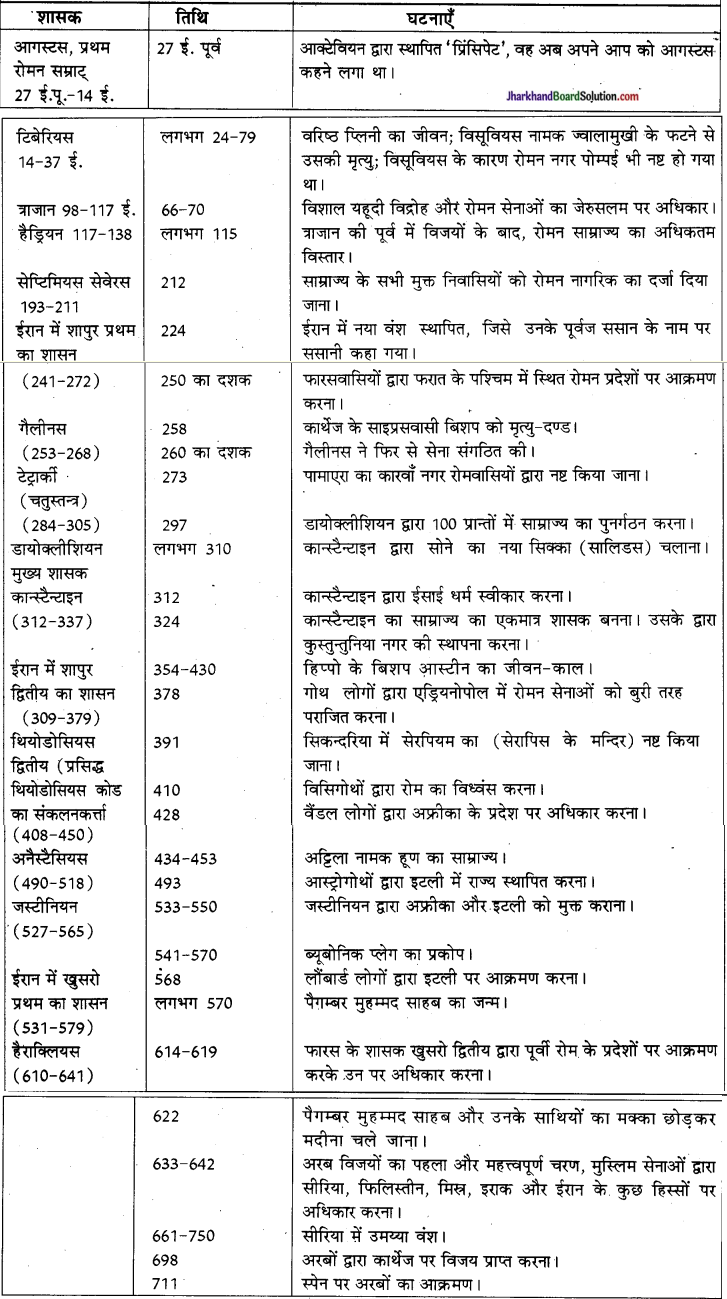
![]()
![]()
![]()
![]()
![]()
![]()
